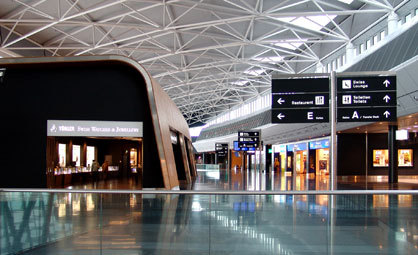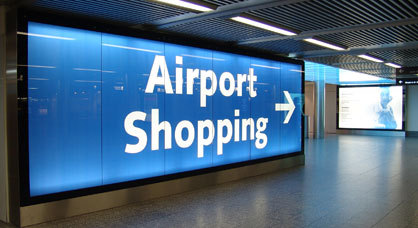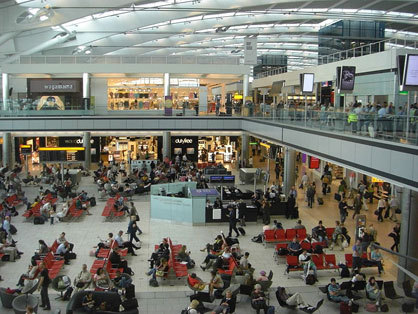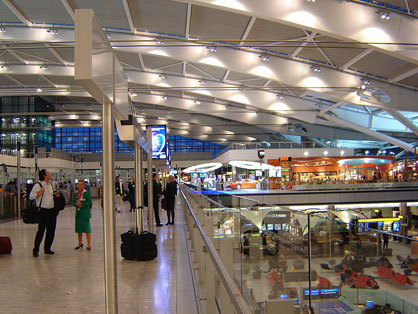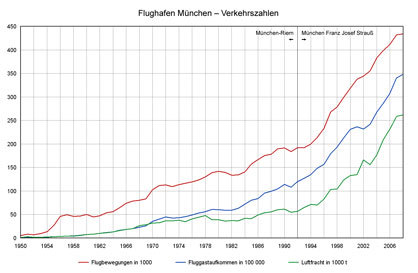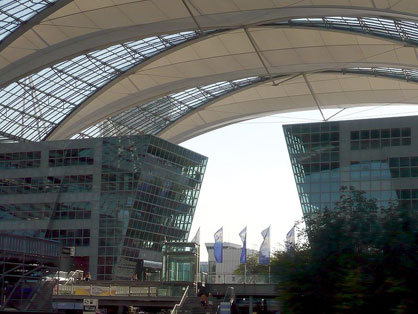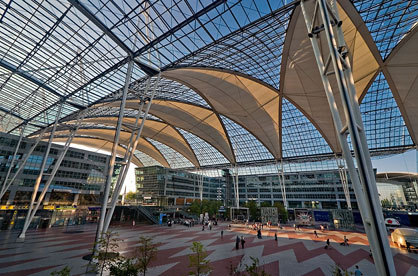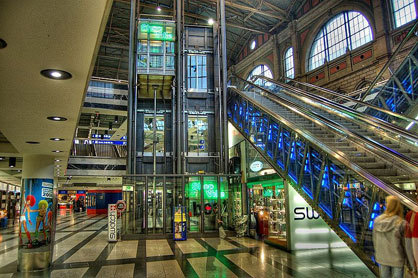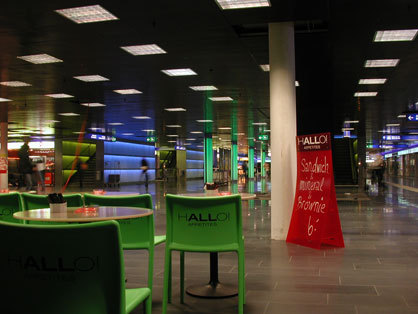Transit Shopping
Text by Susanne Fritz
Switzerland
29.09.09
The retail industry is going through a difficult time and has been complaining about stagnation in its customer base. The big shopping malls are competing with each other to attract shoppers.
The retail industry is going through a difficult time and has been complaining about stagnation in its customer base. The big shopping malls are competing with each other to attract shoppers. Meanwhile, however, retail business at transport hubs such as airports and railway stations is flourishing.
The following projects illustrate the transformation of these infrastructural buildings into 'rail cities' and 'airport cities'.
Zurich airport. Architecture: Nicholas Grimshaw. Photo: Burri AG
Airport shopping is high-frequency retail, providing a growing volume of customers and a captive audience with known retail demographics.
Travellers tend to spend their remaining currency or need a souvenir or a gift. An increasing number of airline passengers and growing air traffic promise further growth.
The global uniformity of brands and status symbols makes it easier to reach an international pool of customers, while at the same time there is room for shops with a regional assortment for the frequent traveller, who is looking for something special and wants to escape the trap of global sameness.
For the transit passenger, shopping at the airport is attractive as a pastime. He has the time to look for luxury bargains or gifts. Providing services at airports is therefore a prospering business which adapts to the 24-hour nature of global travel. The transit passenger doesn’t want to experience the airport as just a transition point but looks for quality in the time spent there and so is ready to take advantage of the services offered. Flexible hours and the wide range of these services make them attractive for locals and visitors as well.
The rising importance of the non-travel sector also changes the concept of the airport: Originally planned as an infrastructural building, the distance from check-in to gate was kept as short as possible. The modern airport makes the passenger pass by as many shops as possible. The dynamic architecture and the spacious halls are designed to work as shopping malls: a roofed mall, airy, and flooded with light.
But airports aren’t only focusing on retail and catering: they have also started to invest in recreational facilities, entertainment and real-estate development. Airports are changing into city-like structures, so called airport cities.
Zurich airport. Architecture: Nicholas Grimshaw. Photo: Burri AG
The rising importance of the non-travel sector also changes the concept of the airport: Originally planned as an infrastructural building, the distance from check-in to gate was kept as short as possible. The modern airport makes the passenger pass by as many shops as possible. The dynamic architecture and the spacious halls are designed to work as shopping malls: a roofed mall, airy, and flooded with light. But airports aren’t only focusing on retail and catering: they have also started to invest in recreational facilities, entertainment and real-estate development. Airports are changing into city-like structures, so called airport cities.
The Zurich airport tries to attract residents to shop there by reimbursing the parking fee. Shopping at the airport includes sightseeing and entertainment: observer platforms, exhibitions, round-trips and the organisation of children’s birthday parties are offered. The newly built Radisson Hotel has a direct connection to the terminal and offers 23 meeting rooms and a conference center.
Since the Schengen agreement, duty-free shopping is possible only in Norway and Switzerland; for all other European airports only if the passenger has a boarding pass with a destination outside the EU.
Following the Norwegian example, Switzerland will shortly introduce the 'duty-free on arrival' to profit more from this opportunity. This means that travellers will soon be able to shop even after arrival.
Unique, the operating company of the Zurich airport, could develop it further despite the resistance of the residents annoyed by aircraft noise. The expansion is lucrative: in 2002 non-travel business created around 230,000 dollars of turnover; in 2008 already around 320,000 dollars.
For the ultramodern annex that serves as a link to Terminal E and later developments only the most sophisticated and finest materials were used. Terrazzo flooring, wood veneers and costly construction details bear the signature of Nicholas Grimshaw Architects and create a top location for luxury brands.
The potential of the airport as a destination was discovered early by the airport operating company BAA, an abbreviation that has been ironically interpreted as 'build another arcade'. BAA is the leader in the non-aeronautical sector: Heathrow airport’s revenues from non-travel business already made 50% before the building of the new terminal by star architect Richard Rogers.
With the new Terminal 5, he designed a hybrid of shopping center and airport: the passenger enters the four-storey building on the top floor that measures more than 55,000 square meters. The whole area is covered by one single vaulted roof that is supported by tree-shaped columns. After check-in, passengers find themselves in a shopping universe that leaves nothing to be desired and where global brands meet local brands. Admittedly, Terminal 5 remains exclusive for those with a flight ticket, but that will do: in July 2009 alone 2.4 million people took off from the new terminal.
It was 10 years ago that the Munich Airport Center (MAC), by Chicago’s famous architect Helmut Jahn, opened its doors. The center connects Terminal 1 and Terminal 2 and therefore occupies a central position.
Both L-shaped buildings of the MAC embrace a 10,000-square-meter plaza, the MAC Forum, which is the largest roofed open space in Europe. The spectacular roofscape, made of translucent, Teflon-coated fibreglass membranes and safety glass, is suspended by 14 pylons. While the Forum provides space for events such as Christmas markets, beach volleyball tournaments, ice-skatiing, and so on, the MAC complex contains a shopping center, services and a medical and conference center.
The new Terminal 2 has, in addition to luxury shops and gourmet catering, a miniature of Herzog & de Meuron’s famous Allianz Arena Stadium, where business passengers have access to interactive touchscreens to get the latest news on economics, politics, finance and sport.
Even though the airplane is considered the most important means of transport in the globalised world and the number of passengers seems to grow constantly, strict airport security controls and the resulting waiting time as well as the construction of speed trains give the railways a competitive advantage.
Furthermore, railway stations themselves are no longer solely counter and platform areas. Extended opening hours and shopping on Sundays and public holidays are attractive for those who prefer to shop in the center of the city.
Shopville, at Zurich’s main station, was planned as an underground passageway with a shopping arcade. It eventually became part of the underground shopping center Railcity when the metropolitan railway, located at the major public transport hub of Switzerland, opened up. The subterranean malls are direct short-cuts to the city center, crossed by those who want to get quickly from the national museum to the high street stores on Bahnhofstrasse or to the tram stops. Cultural events such as movies or concerts also often take place at Zurich’s main station. Besides the broad spectrum of gourmet shops, once a week there is a delicacy food market. The medical center 'Permanence' takes care of patients around the clock and a dental center serves customers 365 days a year from early morning to late evening.
In August 2008 the new shopping mall Forum 1 in Salzburg by Kofler Architects opened. It is located right next to the Salzburg main station that is frequented by up to 57,000 people per day. The Salzburg station is the biggest public transport hub in Western Austria, and the shopping center is conveniently connected to the transport network, from express trains to local buses. For car drivers an underground parking garage with 330 parking spaces was constructed, equipped with a highly modern routing system. Strategically located, the Forum 1 is an attractive passageway between the main station plaza and the Cineplexx theatre, and is directly linked to the newly built four-star Ramada Hotel.
To come full circle, we return to Zurich for the latest example of this broader use of transport centers. A major architectural competition for a project called 'The Circle at Zurich Airport' has begun.The approximately 1-billion-dollar project will incorporate two hotels and service facilities including wellness, health, education and events. The winning architect will be the next one to take another step towards the change of airports into citylike structures. Start of construction will be 2012.
